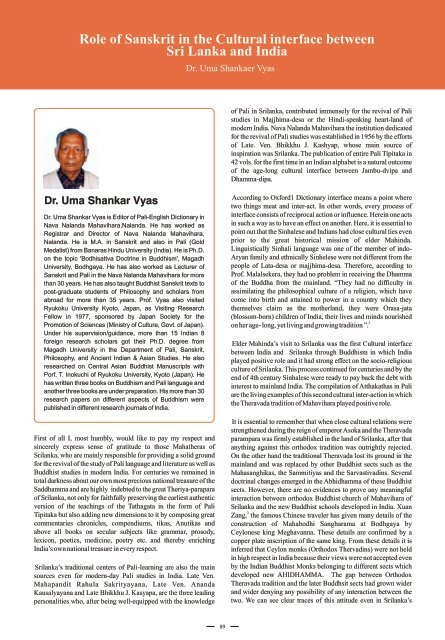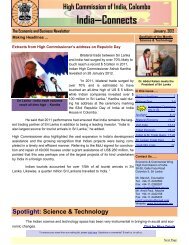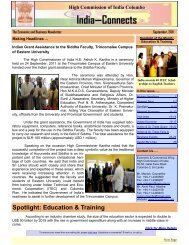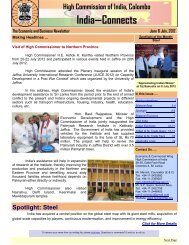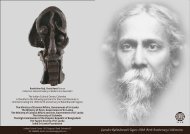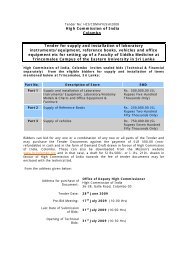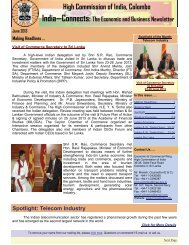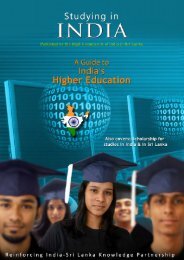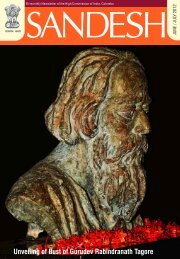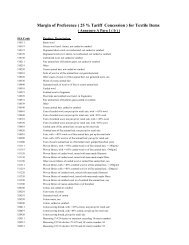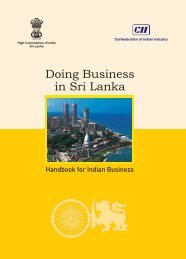Papers presented at the International Buddhist Conference, March ...
Papers presented at the International Buddhist Conference, March ...
Papers presented at the International Buddhist Conference, March ...
You also want an ePaper? Increase the reach of your titles
YUMPU automatically turns print PDFs into web optimized ePapers that Google loves.
Role of Sanskrit in <strong>the</strong> Cultural interface between<br />
Sri Lanka and India<br />
Dr. Uma Shankaer Vyas<br />
of Pali in Srilanka, contributed immensely for <strong>the</strong> revival of Pali<br />
studies in Majjhima-desa or <strong>the</strong> Hindi-speaking heart-land of<br />
modern India. Nava Nalanda Mahavihara <strong>the</strong> institution dedic<strong>at</strong>ed<br />
for <strong>the</strong> revival of Pali studies was established in 1956 by <strong>the</strong> efforts<br />
of L<strong>at</strong>e. Ven. Bhikkhu J. Kashyap, whose main source of<br />
inspir<strong>at</strong>ion was Srilanka. The public<strong>at</strong>ion of entire Pali Tipitaka in<br />
42 vols. for <strong>the</strong> first time in an Indian alphabet is a n<strong>at</strong>ural outcome<br />
of <strong>the</strong> age-long cultural interface between Jambu-dvipa and<br />
Dhamma-dipa.<br />
Dr. Uma Shankar Vyas<br />
Dr. Uma Shankar Vyas is Editor of Pali-English Dictionary in<br />
Nava Nalanda Mahavihara,Nalanda. He has worked as<br />
Registrar and Director of Nava Nalanda Mahavihara,<br />
Nalanda. He is M.A. in Sanskrit and also in Pali (Gold<br />
Medalist) from Banaras Hindu University (India). He is Ph.D.<br />
on <strong>the</strong> topic 'Bodhis<strong>at</strong>tva Doctrine in Buddhism', Magadh<br />
University, Bodhgaya. He has also worked as Lecturer of<br />
Sanskrit and Pali in <strong>the</strong> Nava Nalanda Mahavihara for more<br />
than 30 years. He has also taught <strong>Buddhist</strong> Sanskrit texts to<br />
post-gradu<strong>at</strong>e students of Philosophy and scholars from<br />
abroad for more than 35 years. Prof. Vyas also visited<br />
Ryukoku University Kyoto, Japan, as Visiting Research<br />
Fellow in 1977, sponsored by Japan Society for <strong>the</strong><br />
Promotion of Sciences (Ministry of Culture, Govt. of Japan).<br />
Under his supervision/guidance, more than 15 Indian 8<br />
foreign research scholars got <strong>the</strong>ir Ph.D. degree from<br />
Magadh University in <strong>the</strong> Department of Pali, Sanskrit,<br />
Philosophy, and Ancient Indian & Asian Studies. He also<br />
researched on Central Asian <strong>Buddhist</strong> Manuscripts with<br />
Porf. T. Inokuchi of Ryukoku University, Kyoto (Japan). He<br />
has written three books on Buddhism and Pali language and<br />
ano<strong>the</strong>r three books are under prepar<strong>at</strong>ion. His more than 30<br />
research papers on different aspects of Buddhism were<br />
published in different research journals of India.<br />
First of all I, most humbly, would like to pay my respect and<br />
sincerely express sense of gr<strong>at</strong>itude to those Mah<strong>at</strong>heras of<br />
Srilanka, who are mainly responsible for providing a solid ground<br />
for <strong>the</strong> revival of <strong>the</strong> study of Pali language and liter<strong>at</strong>ure as well as<br />
<strong>Buddhist</strong> studies in modern India. For centuries we remained in<br />
total darkness about our own most precious n<strong>at</strong>ional treasure of <strong>the</strong><br />
Saddhamma and are highly indebted to <strong>the</strong> gre<strong>at</strong> Theriya-parapara<br />
of Srilanka, not only for faithfully preserving <strong>the</strong> earliest au<strong>the</strong>ntic<br />
version of <strong>the</strong> teachings of <strong>the</strong> T<strong>at</strong>hag<strong>at</strong>a in <strong>the</strong> form of Pali<br />
Tipitaka but also adding new dimensions to it by composing gre<strong>at</strong><br />
commentaries chronicles, compendiums, tikas, Anutikas and<br />
above all books on secular subjects like grammar, prosody,<br />
lexicon, poetics, medicine, poetry etc. and <strong>the</strong>reby enriching<br />
India’s own n<strong>at</strong>ional treasure in every respect.<br />
Srilanka’s traditional centers of Pali-learning are also <strong>the</strong> main<br />
sources even for modern-day Pali studies in India. L<strong>at</strong>e Ven.<br />
Mahapandit Rahula Sakrityayana, L<strong>at</strong>e Ven. Ananda<br />
Kausalyayana and L<strong>at</strong>e Bhikkhu J. Kasyapa, are <strong>the</strong> three leading<br />
personalities who, after being well-equipped with <strong>the</strong> knowledge<br />
According to Oxford1 Dictionary interface means a point where<br />
two things me<strong>at</strong> and inter-act. In o<strong>the</strong>r words, every process of<br />
interface consists of reciprocal action or influence. Herein one acts<br />
in such a way as to have an effect on ano<strong>the</strong>r. Here, it is essential to<br />
point out th<strong>at</strong> <strong>the</strong> Sinhalese and Indians had close cultural ties even<br />
prior to <strong>the</strong> gre<strong>at</strong> historical mission of elder Mahinda.<br />
Linguistically Sinhali language was one of <strong>the</strong> member of indo-<br />
Aryan family and ethnically Sinhelese were not different from <strong>the</strong><br />
people of L<strong>at</strong>a-desa or majjhima-desa. Therefore, according to<br />
Prof. Malalsekera, <strong>the</strong>y had no problem in receiving <strong>the</strong> Dhamma<br />
of <strong>the</strong> Buddha from <strong>the</strong> mainland. “They had no difficulty in<br />
assimil<strong>at</strong>ing <strong>the</strong> philosophical culture of a religion, which have<br />
come into birth and <strong>at</strong>tained to power in a country which <strong>the</strong>y<br />
<strong>the</strong>mselves claim as <strong>the</strong> mo<strong>the</strong>rland, <strong>the</strong>y were Orasa-j<strong>at</strong>a<br />
(blossom-born) children of India, <strong>the</strong>ir lives and minds nourished<br />
2<br />
on her age- long, yet living and growing tradition ”.<br />
Elder Mahinda’s visit to Srilanka was <strong>the</strong> first Cultural interface<br />
between India and Srilanka through Buddhism in which India<br />
played positive role and it had strong effect on <strong>the</strong> socio-religious<br />
culture of Srilanka. This process continued for centuries and by <strong>the</strong><br />
end of 4th century Sinhalese were ready to pay back <strong>the</strong> debt with<br />
interest to mainland India. The compil<strong>at</strong>ion of Atthak<strong>at</strong>has in Pali<br />
are <strong>the</strong> living examples of this second cultural inter-action in which<br />
<strong>the</strong> Theravada tradition of Mahavihara played positive role.<br />
It is essential to remember th<strong>at</strong> when close cultural rel<strong>at</strong>ions were<br />
streng<strong>the</strong>ned during <strong>the</strong> reign of emperor Asoka and <strong>the</strong> Theravada<br />
parampara was firmly established in <strong>the</strong> land of Srilanka, after th<strong>at</strong><br />
anything against this orthodox tradition was outrightly rejected.<br />
On <strong>the</strong> o<strong>the</strong>r hand <strong>the</strong> traditional Theravada lost its ground in <strong>the</strong><br />
mainland and was replaced by o<strong>the</strong>r <strong>Buddhist</strong> sects such as <strong>the</strong><br />
Mahasanghikas, <strong>the</strong> Sammitiyas and <strong>the</strong> Sarvastivadins. Several<br />
doctrinal changes emerged in <strong>the</strong> Abhidhamma of <strong>the</strong>se <strong>Buddhist</strong><br />
sects. However, <strong>the</strong>re are no evidences to prove any meaningful<br />
interaction between orthodox <strong>Buddhist</strong> church of Mahavihara of<br />
Srilanka and <strong>the</strong> new <strong>Buddhist</strong> schools developed in India. Xuan<br />
3<br />
Zang, <strong>the</strong> famous Chinese traveler has given many details of <strong>the</strong><br />
construction of Mahabodhi Sangharama <strong>at</strong> Bodhgaya by<br />
Ceylonese king Meghavanna. These details are confirmed by a<br />
copper pl<strong>at</strong>e inscription of <strong>the</strong> same king. From <strong>the</strong>se details it is<br />
inferred th<strong>at</strong> Ceylon monks (Orthodox Thervadins) were not held<br />
in high respect in India because <strong>the</strong>ir views were not accepted even<br />
by <strong>the</strong> Indian <strong>Buddhist</strong> Monks belonging to different sects which<br />
developed new AHIDHAMMA. The gap between Orthodox<br />
Theravada tradition and <strong>the</strong> l<strong>at</strong>er Buddhsit sects had grown wider<br />
and wider denying any possibility of any interaction between <strong>the</strong><br />
two. We can see clear traces of this <strong>at</strong>titude even in Srilanka’s<br />
89


